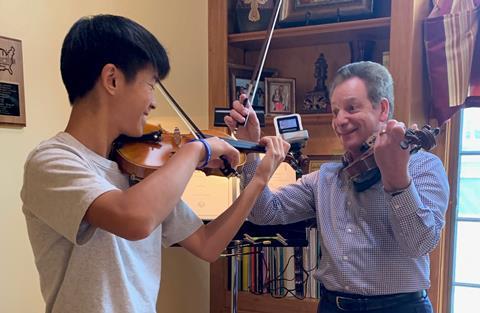Violinist and Ohio State University professor of music education Bob Gillespie shares his step-by-step guide for success
The following is an extract from the January 2020 issue. Click here to log in or subscribe. The January 2020 digital magazine and print edition are on sale now.
 Bob Gillespie teaching one of his students: Celerebrating success is key to developing a positive relationship with teenage students, he says
Bob Gillespie teaching one of his students: Celerebrating success is key to developing a positive relationship with teenage students, he says
Understanding adolescents and knowing how to motivate them effectively can be a mystery. At last week’s lesson they were focused, eager to learn and even inspiriting to be with! This week they are moody, distracted and daydreamy. You try to teach them, but at times they frown, sigh and roll their eyes. One week they practise well for their lesson – the next week they do not. You are feverishly trying to prepare them for a performance in six weeks’ time, but they are not that concerned about the performance because it is six weeks away! What is going on? How can we effectively motivate them to be consistent in their focus, practice and desire to play better? Fortunately, scientists have found strategies that can help us.
Who are adolescents? Who are they, really? Understanding them is the first step to motivating them effectively. Researchers such as Kim Dolgin (author of The Adolescent: Development, Relationships, and Culture, 14th edition, 2018) have identified characteristics typical of adolescents, and those that can most guide our teaching are listed in this article.
How can this understanding be used to motivate adolescents? The following are two examples from the twelve strategies you can use:
Let them question Adolescents are in the process of developing their own set of values. From these values, they learn to make decisions. They ask: Why should I play the violin? Do I really want to play the violin? Why do I have to practise? Why do I have to play this kind of music? Why do I have to do it this way? Do not be threatened by their questions. Do not be defensive. Be open. Do not feel like you are being personally attacked or disrespected. Take their questions seriously and answer them. Their questioning behaviour is healthy.
Let them make decisions Adolescent brains are different, as noted by neurologist Frances Jensen in The Teenage Brain: A Neuroscientist’s Survival Guide to Raising Adolescents and Young Adults (2014). An adult can often wonder, ‘What were they thinking!’ The frontal lobes where decisions are made in the brain are not yet connected when we are adolescent. That is why teens believe in chance. Decision-making (‘Is this a good or a bad idea?’) and the relationship between actions and consequences are not default behaviours at this point in our lives. However, adolescents delight in making their own decisions, as it makes them feel free and independent. They feel empowered.
Here are four possible scenarios: you have set multiple tasks and now you let them choose which to demonstrate first; you have assigned them three different scales to prepare and now ask them which one they would like to play first; you select three solos that align with your pedagogical goals for the student and allow them to choose which one to work on first; you ask them to choose which solo – of the three they have learnt to play most recently – they would like to perform in the upcoming studio recital.
To read the full article in the January 2020 issue of The Strad, click here to log in or subscribe.
The January 2020 digital magazine and print edition are on sale now.











































No comments yet